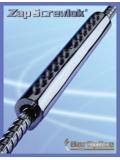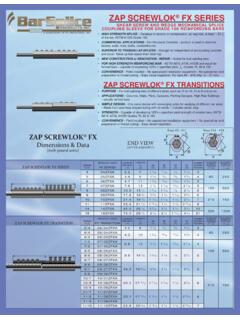Transcription of Grounding & Bonding - The Energy Education Council
1 Grounding & BondingSeptember 18-20, 2007 ERICO, Fitzgerald, PE ERICO, Inc. has met the standards and requirements of the Registered Continuing Education Providers Program. Credit earnedon completion of this program will be reported to RCEPP. A certificate of completion will be issued to each participant. As such, it does not include content that may be deemed or construed to be an approval or endorsement by NCEES or RCEPP. COPYRIGHT MATERIALSThis educational activity is protected by and International copyright laws. Reproduction, distribution, display and use of the educational activity without written permission of the presenter is prohibited. ERICO Inc., 2007 Learning ObjectivesAt the end of this presentation you will be able to: Discuss the basics of electrical Grounding and Bonding . Discuss electrical engineering principles and relevant specifications. Discuss the basic design criteria for Grounding Basic Electricity and Materials Utility Grounding C & I Residential Grounding Telecommunications Systems ConsiderationsPurpose of system GroundingSystem Grounding :The intentional connection of a phase or neutral conductor to EARTH for the propose of controlling the voltage to EARTH or GROUND within predictable limits.
2 It also provides for a flow of current that will allow detection of an unwanted connection between system conductors and ground which may instigate operation of automatic devices to remove the source of voltage. The control of voltage also allows reduction of shock hazard to person who might come in contact with live 142-1991 (Green Book) Purpose of Grounding Limit potential difference of neutralfor system stability Allow for operation of relays and system protections devices Personnel safetyThis is different from most Grounding presentations; if you do the first two, you will get safety for free. Basic Electrical Theory ResistivityResistivityis the intrinsic property of a material to impede the flow of electrical current. It is the resistance factored by the length and cross sectional area. It is also referred to as volume mmm = =2 AlRVolume Resistivity of Materials10-810-21041012102 All in m MetalsSoilsWoodInsulatorsSOIL RESISTIVITYLoamClaySand & GravelSurface LimestoneShaleSandstoneGranites, BasaltSlates1 to 50 ohm-m20 to 100 ohm-m50 to 1000 ohm-m100 to 10,000 ohm-m5 to 100 ohm-m20 to 2000 ohm-m10,000 ohm-m10 to 100 ohm-mIMPEDENCEI mpedence: is the sum (and much more complex mathematical operations) of a circuit resistance elements and the REACTANCE which is caused by inductors and capacitive elements in the circuit.
3 IT IS AFFECTED BY FREQUENCY f in Hz. Transients or faults in electrical systems look like very high frequency events, not 60 hz. LXL= CXC1=f 2=Inductive ReactanceCapacitive ReactanceELECTRICAL SYSTEMS - TRANSIENTS ELECTRICAL system Generators, Transformers, and Utilization devices Use the earth as a REFERENCE for system stability The EARTH is not a destinationof currents The system Neutral is the destination for currents Earth is sometimes a conductor during transients NON system TRANSIENTS Lightning is a Non system Transient The EARTH IS a destinationfor currents and they are LARGE MAGNITUDE ELECTRICAL system GENERATION Transforms mechanical Energy to electricity P = 1,300MW @ 30 kV TRANSMISSION P= V x I Losses are proportional to I so V is increased, Iisdecreased for efficient transmission. V >130kV DISTRIBUTION Requires lower voltage for practical handling of components. Substations transform voltage to 15-25kV and then to 480 or 240/120V1,000 MW 30 kVXFMR 500kVGENERATIONTRANSMISSIONDISTRIBUTION5 00 kVXFMR 15-25kVSUBSTATION15-25 kV25 kV XFMR 480V 3 25 kV XFMR 240/120V 1 Typical Utility SystemUTILITY Grounding SUMMARY ESTABLISH REFERENCE TO EARTH Allows for Protection devices to operate Keeps metallic and structures at the potential of the earth CREATES EQUIPOTENTIAL PLANE Significantly reduces risk of step and touch potential PROVIDES LOW IMPEDENCE PATH Especially for system and NON system transientsAC Three Phase 3 PHASE 2 3 4 5 6 7 8 9 1011121314151617181920212223242526272829 3031323334353637 Angle (/10)Phase APhase BPhase CGround SystemReferenceUtility Substation GroundingSubstations have high fault currents and potential for voltages caused by that current.
4 Fault Currents > 50kARIV =SAFTEY At 50-60 Hz 60-100mA can cause ventricular fibrillation. Threshold voltage can be as low as 50 VTYPICAL SUBSTATION GROUDNING 4/0 Cu buried at 18 10-20 grid, welded Ground Rods every 20 typical. Extremely low R IEEE 80 Typ Provides a Molecular Bond Between Conductors Current Carrying Capacity Equal to that of the Conductor Permanent - Cannot Loosen or Corrode to Cause a High-Resistance Connection Requires No External Source of Power or Heat Can be Visually Checked for QualityExothermic Welding for ConnectionsExothermic Welding ProcessAluminum Reduces Copper Oxide, Forming Super Heated Copper and Aluminum Oxide (Slag)3Cu2O +2Al --> 6Cu + Al2O3+ HEAT Mechanical / Compression Connections Joint Resistance (RJ) Contact or Interface Resistance (Rc) Surface is Actually Consists of Many Points of Contact Actual Area or Contact of Joint is Much Less than Surface Area Brought Together Dependent on Applied Pressure Spreading Resistance (Rs) Diversion of Current Flow (Current Path is Not Uniform)
5 Rj= Rc+ RsComparison of Mechanical and Exothermic ConnectionsMolecular Bonds Guarantee Conductivity Across the Entire SectionContact and Spreading Resistance (Rs) Portion of Connection is ZeroMolecular BondMechanicalConnectionC & I Grounding Generally C & I and Residential Grounding methods establish a good earth reference Also Grounding elements provide a path for fault currents All metal parts associated with the electrical system shall be connected to the ground reference for 250 Definition of Grounding Intentional permanent low impedancePath to carry fault current Capacity to carry ground fault current Returns fault current to SOURCE,NOT EARTH Is connected to EARTH for system REFERENCE Used to allow operation of protection devicesC & I and Residential system GroundingElements GROUNDED CONDUCTOR -NEUTRAL Grounding ELECTRODE -SEVERAL Grounding ELECTRODE CONDUCTOR SERVICE Bonding JUMPER EQUIPMENT Grounding CONDUCTORS olidly Grounded 3 Phase Electrical SystemOther GroundingElectrodes& BondsNEW MUST Be Bonded into GEC SystemMain Bonding JumperNeutral GroundedConductorEquipment Grounding ConductorsTypical Grounding Connections in small Main Service PanelDifference between Neutral (Grounded) and Grounding ConductorNEC 250 Resistance Requirement Section requires < 25 resistance for pipe, rod or plate electrodes OR Add another electrode > 6 away from the first, WITHOUT FURTHER MEASUREMENT =dllRO4ln2 Using this formula for resistance (from MIL Handbook 419)rod of Resistance =ORdiameter Rod =dlength rod =lyResistivit Volume Soil = Source.
6 By 10 in 500 M soil would have a resistance of over 160 Practical Ground Resistance Most rods have much less than 160 Typical rod resistances will be less than 25 in most soils because of the existence of proximate utility ground ground resistance (< 10 ) can be achieved with Multiple Rods bonded together Counterpoise system Coupled rods Conductive Enhancement Materials Chemical RodsBeware of False ClaimsUL 467 Bend Test Results Galvanize Rod Copper Electroplated RodUL 467 Bend Test Results - Cu RodBONDING Interconnecting of all Ground Electrode Systems Electrical Power Grounding system Lightning Grounding system Telecommunications Grounding system Cable Grounding system Connect all conductive objects together both internal and external to the facility Provides near zero voltage differenceduring ground potential riseOther Grounding and Bonding Applications Signal Reference Grids Grounding Bus Bars Equipotential Mesh Rebar Clamps Swimming Pool Grounding Wind Mill GroundingSRG for low impedance ground Stops noise from interfering with low voltage digital signals.
7 Provides a lower impedance ground reference than signal conductors and shields. Minimizes voltage potential difference between interconnected Impedance vs. FreqSignal Reference Grids Sensitive Electronics Grounding Applications: Reduce step & touch potential Signal Reference Grid Antenna ground screen Electronic shielding Configuration: Wire: #6 to #12 - 30 %CW, 40% CW, Cu Mesh size: 2 x 2 up to 48 x 24 20 maximum width - 500 lb maximum weight Wire overhang for field splicing using PG style WIRE MESHEIA/TIA Ground Bars and Ground PlatesTGB and TMGB Grounding Bus BarsMain Elements of Telecom Grounding and Bonding Equipment Bonding Conductor for Telecommunications Telecom Main Grounding Busbar (TMGB)---------------------------------- ------------------- Telecomm Bonding Backbone (TBB) Telecomm Grounding Busbar (TGB) Telecomm Bonding Backbone InterconnectingBonding Conductor for TelecommunicationsBonding conductor for telecommunicationsEquipmentTelecommunica tionsEntrance FacilityElectrical Entrance FacilityTMGBG rounding Electrode ConductorService EquipmentNGTBBO utside the scope of this StandardWithin the scope of this Standard EquipmentTelecommunicationsEntrance Facility (TEF)Telecommunications Main Grounding Busbar (TMGB)EquipmentTelecommunications Room (TR)Telecommunications Room (TR)Telecomm unications Bonding Backbone (TBB)
8 LEGEND Cross connect Grounding bar Service equipmentElectrical Entrance FacilityGrounding Electrode SystemGrounding Electrode ConductorBonding conductor for telecommunicationsTGBTGBM etal Frame of BuildingEquipment Panelboard Outside scope of this standard Bonding conductor as labeledTelecommunications Grounding Busbar (TGB)EquipmentEquipment Room (ER)PathwaysEquipmentGrounding Equalizer (GE)EquipmentTGBT elecom munications Room (TR)TGBT elecommunications Room (TR) Grounding and Bonding SUMMARY Discussed Basic Electricity Understand Resistivity Should know why Utilities Ground their systems Should know elements of commercial industrial- residential Grounding Telecom Bonding and Grounding

